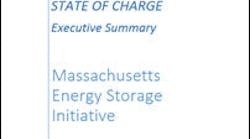There is great potential in Massachusetts for new advanced energy storage to enhance the efficiency, affordability, resiliency and cleanliness of the entire electric grid by modernizing the way we generate and deliver electricity. In order to increase energy storage deployment, this Study presents a comprehensive suite of policy recommendations to generate 600 MW of advanced energy storage in the Commonwealth by 2025, thereby capturing $800 million in system benefits to Massachusetts ratepayers.
Increasing the amount of storage capacity on the power grid has the potential to transform the way we generate and consume electricity for the benefit of Massachusetts ratepayers. As compared to other commodities, the electricity market currently has the least amount of storage in its supply chain. Other commodities, including food, water, gasoline, oil and natural gas, have an average storage capacity of 10% of the daily consumption (See Figure 1). The electricity market currently has only a storage capacity of 1% of daily electricity consumption in Massachusetts. In addition to having a small storage capacity, electricity is also the fastest supply chain traveling at 1,800 miles per second, meaning that without storage electricity needs to be produced, delivered, and consumed nearly instantaneously for the grid to maintain balance. This requires grid infrastructure –including generation, transmission and distribution systems — to be sized to manage the highest peak usage of the year, despite consumer electricity demand varying significantly both throughout the day and at different seasons of the year (See Figure 2).
The need to size all grid infrastructure to the highest peak results in system inefficiencies, under utilization of assets, and high cost to ratepayers. These high costs can be seen in the highly variable hourly electricity prices. Over the last three years from 2013 – 2015 on average, the top 1% most expensive hours accounted for 8% ($680 million) of Massachusetts ratepayers’ annual spend on electricity. The top 10% of hours during these years, on average, accounted for 40% of annual.
